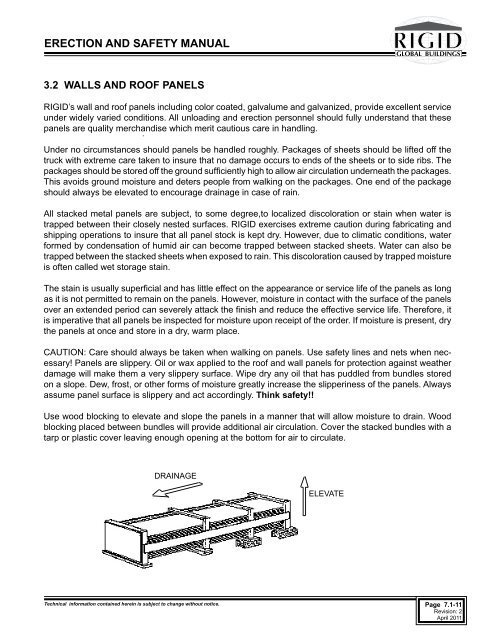ERECTION AND SAFETY MANUAL - Rigid Global Buildings
ERECTION AND SAFETY MANUAL - Rigid Global Buildings
ERECTION AND SAFETY MANUAL - Rigid Global Buildings
Create successful ePaper yourself
Turn your PDF publications into a flip-book with our unique Google optimized e-Paper software.
<strong>ERECTION</strong> <strong>AND</strong> <strong>SAFETY</strong> <strong>MANUAL</strong><br />
3.2 WALLS <strong>AND</strong> ROOF PANELS<br />
RIGID’s wall and roof panels including color coated, galvalume and galvanized, provide excellent service<br />
under widely varied conditions. All unloading and erection personnel should fully understand that these<br />
panels are quality merchandise which merit cautious care in handling.<br />
Under no circumstances should panels be handled roughly. Packages of sheets should be lifted off the<br />
truck with extreme care taken to insure that no damage occurs to ends of the sheets or to side ribs. The<br />
packages should be stored off the ground suffi ciently high to allow air circulation underneath the packages.<br />
This avoids ground moisture and deters people from walking on the packages. One end of the package<br />
should always be elevated to encourage drainage in case of rain.<br />
All stacked metal panels are subject, to some degree,to localized discoloration or stain when water is<br />
trapped between their closely nested surfaces. RIGID exercises extreme caution during fabricating and<br />
shipping operations to insure that all panel stock is kept dry. However, due to climatic conditions, water<br />
formed by condensation of humid air can become trapped between stacked sheets. Water can also be<br />
trapped between the stacked sheets when exposed to rain. This discoloration caused by trapped moisture<br />
is often called wet storage stain.<br />
The stain is usually superfi cial and has little effect on the appearance or service life of the panels as long<br />
as it is not permitted to remain on the panels. However, moisture in contact with the surface of the panels<br />
over an extended period can severely attack the fi nish and reduce the effective service life. Therefore, it<br />
is imperative that all panels be inspected for moisture upon receipt of the order. If moisture is present, dry<br />
the panels at once and store in a dry, warm place.<br />
CAUTION: Care should always be taken when walking on panels. Use safety lines and nets when necessary!<br />
Panels are slippery. Oil or wax applied to the roof and wall panels for protection against weather<br />
damage will make them a very slippery surface. Wipe dry any oil that has puddled from bundles stored<br />
on a slope. Dew, frost, or other forms of moisture greatly increase the slipperiness of the panels. Always<br />
assume panel surface is slippery and act accordingly. Think safety!!<br />
Use wood blocking to elevate and slope the panels in a manner that will allow moisture to drain. Wood<br />
blocking placed between bundles will provide additional air circulation. Cover the stacked bundles with a<br />
tarp or plastic cover leaving enough opening at the bottom for air to circulate.<br />
DRAINAGE<br />
ELEVATE<br />
Technical information contained herein is subject to change without notice. Page 7.1-11<br />
Revision: 2<br />
April 2011


